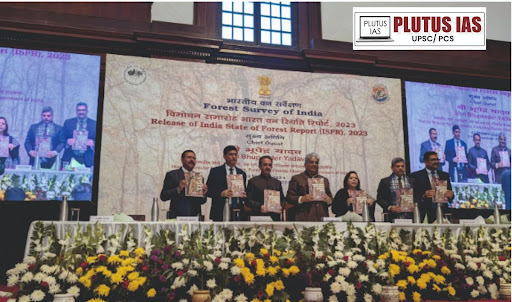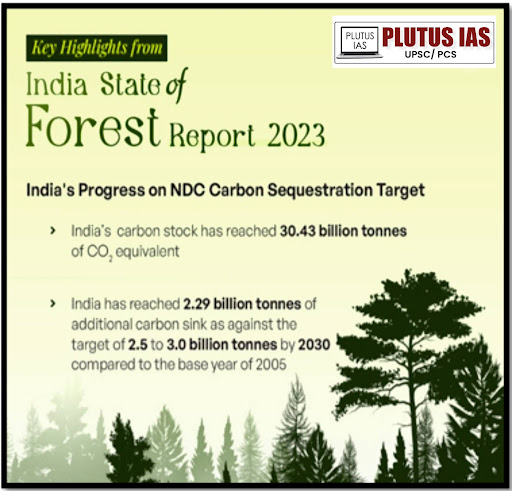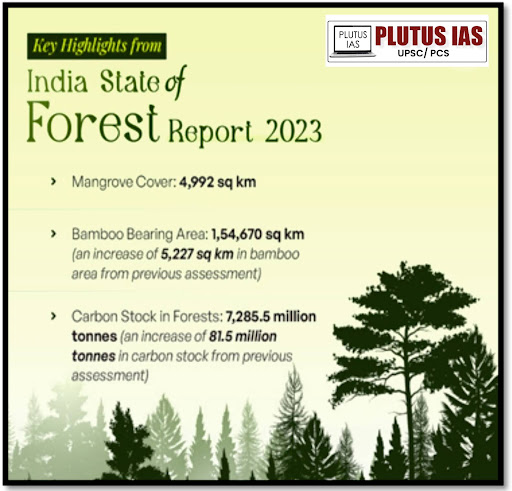30 Dec India’s Green Recovery: Pathway to Sustainable Growth
This article covers “Daily Current Affairs,” and the topic details related to India’s Green Recovery: Pathway to Sustainable Growth
Syllabus mapping:
GS-3:Environment: Biodiversity and forest conservation.
For Prelims:
Key facts and findings of the ISFR 2023. various government initiatives to promote the frost in India.
For Mains:
What is the Significance of such reports and challenges associated with deforestation and what are ways to address the challenges related to deforestation?
Why in the news?
The India State of Forest Report 2023 (ISFR 2023) was released by the Minister for Environment, Forest and Climate Change, Shri Bhupender Yadav, at the Forest Research Institute, Dehradun.

Key Facts about Forest Survey of India (FSI)
| Aspect | Details |
|---|---|
| Founded | June 1981 |
| Headquarters | Dehradun, Uttarakhand |
| Parent Ministry | Ministry of Environment, Forest and Climate Change, Government of India |
| Primary Functions | Conduct forest surveys, studies, and research to monitor land and forest resources and provide data for national planning and conservation. |
| Predecessor | Preinvestment Survey of Forest Resources (PISFR), initiated in 1965 with sponsorship from FAO and UNDP. |
| Origin | Created based on the 1976 recommendation of the National Commission on Agriculture (NCA). |
| Biennial Reports | Publishes the “State of Forest Report” (SFR) every two years since 1987. |
| Forest Cover Monitoring | Uses remote sensing satellite data and GIS technology for digital interpretation. |
| Forest Fire Monitoring | Active since 2004, uses MODIS (Moderate-Resolution Imaging Spectrometer) and GIS technology. |
| Training | Provides training to forester cadres of various Indian states. |
| Publications | – “The Indian State of Forest Reports” (biennial). – Area-specific “Inventory and Wood Consumption Studies”. |
India State of Forest Report:
Biennial Publication: Prepared by the Forest Survey of India (FSI), the ISFR has been published every two years since 1987.
18th Edition: The 2023 report marks the 18th release in the series.
Comprehensive Assessment: It involves a detailed analysis of India’s forest and tree resources using: 1) Remote Sensing Satellite Data. 2) Field-Based National Forest Inventory (NFI).


The Forest Report contains the following:
1. Forest Cover
2. Tree Cover
3. Mangrove Cover
4. Growing Stock
5. Carbon Stock in India’s Forests
6. Instances of Forest Fire
7. Agroforestry.
Major Findings of the India State of Forest Report 2023
| Category | Details |
|---|---|
| Forest and Tree Cover | 8,27,357 sq km (25.17% of geographical area), comprising 7,15,343 sq km (21.76%) as forest cover and 1,12,014 sq km (3.41%) as tree cover. |
| Increase since 2021 Assessment | Forest and tree cover increased by 1,445 sq km, including 156 sq km of forest cover and 1,289 sq km of tree cover. |
| Top States by Forest & Tree Cover Increase | 1. Chhattisgarh (684 sq km) 2. Uttar Pradesh (559 sq km) 3. Odisha (559 sq km) 4. Rajasthan (394 sq km) |
| Top States by Forest Cover Increase | 1. Mizoram (242 sq km) 2. Gujarat (180 sq km) 3. Odisha (152 sq km) |
| Largest Forest & Tree Cover (Area-wise) | 1. Madhya Pradesh (85,724 sq km) 2. Arunachal Pradesh (67,083 sq km) 3. Maharashtra (65,383 sq km) |
| Largest Forest Cover (Area-wise) | 1. Madhya Pradesh (77,073 sq km) 2. Arunachal Pradesh (65,882 sq km) 3. Chhattisgarh (55,812 sq km) |
| Highest Forest Cover (% of Area) | 1. Lakshadweep (91.33%) 2. Mizoram (85.34%) 3. Andaman & Nicobar Islands (81.62%) |
| States with >33% Forest Cover | 19 states/UTs; 8 of these (Mizoram, Lakshadweep, A&N Islands, Arunachal Pradesh, Nagaland, Meghalaya, Tripura, Manipur) have >75% forest cover. |
| Mangrove Cover | Total: 4,992 sq km. |
| Growing Stock | Total: 6,430 million cum – Inside Forest: 4,479 million cum – Outside Forest: 1,951 million cum Increase: 262 million cum (91 inside forest, 171 outside). |
| Bamboo Bearing Area | Total: 1,54,670 sq km Increase: 5,227 sq km since 2021. |
| Timber Production (Annual Potential) | 91.51 million cum from trees outside forest. |
| Carbon Stock in Forests | Total: 7,285.5 million tonnes Increase: 81.5 million tonnes since 2021. |
| Carbon Sequestration (NDC Target) | India’s carbon stock: 30.43 billion tonnes of CO2 equivalent Additional sink since 2005: 2.29 billion tonnes Target: 2.5–3.0 billion tonnes by 2030. |
| Utility of ISFR Data | Vital for policymakers, planners, State Forest Departments, research organizations, development agencies, academicians, and civil society for conservation and resource management. |
Key Government Policies and Initiatives to Protect and Expand Forest Cover:
| Scheme/Policy | Details |
|---|---|
| National Mission for a Green India (GIM) | Launched in 2014, focuses on enhancing forest cover through protection, restoration, and expansion initiatives. Rs. 944.48 crore allocated to 17 States and 1 UT. |
| Nagar Van Yojana (NVY) | Established in 2020 to develop green spaces in urban and peri-urban areas. 546 projects approved with Rs. 431.77 crore allocated across 31 States/UTs. |
| School Nursery Yojana (SNY) | Aims to raise awareness about tree planting in schools. 743 projects sanctioned in 19 States/UTs with Rs. 4.80 crore allocated. |
| Mangrove Initiative for Shoreline Habitats & Tangible Incomes (MISHTI) | Five-year initiative (2023-2028) to restore mangroves along India’s coastline. Rs. 17.96 crore allocated for states like Andhra Pradesh, Gujarat, Odisha, and more. |
| National Plan for Conservation of Aquatic Ecosystems (NPCA) | Focuses on conservation and management of wetlands through a cost-sharing model between the Central and State Governments. |
| Ek Ped Maa Ke Naam | Launched in 2024 to encourage tree planting in honor of mothers, fostering a personal connection with nature. |
| Compensatory Afforestation Fund Management and Planning Authority (CAMPA) | Offsets forest loss by supporting afforestation projects under the Van Sanrakshan Evam Samvardhan Adhiniyam, 1980. |
| Twenty-Point Programme (Afforestation Targets) | Sets annual afforestation goals for States/UTs through Central and State schemes, NGO participation, and private sector efforts. |
| Awareness and Mass Plantation Drives | Promotes tree planting through events like Van Mahotsav, World Environment Day, and International Day of Forests. |
| Indian Forest Management Standard | Part of the National Working Plan Code – 2023, establishes criteria for sustainable forest management and certification for timber producers. |
| National Action Plan on Forest Fire (2018) | Provides measures to prevent forest fires, enhance resilience, and improve community capacity for fire prevention and control. |
| Joint Forest Management (JFM) | Involves community participation through Joint Forest Management Committees for better forest and wildlife protection, in line with the National Forest Policy, 1988. |
| Conservation of Mangroves and Coral Reefs | Supports coastal States/UTs for mangrove protection under the National Coastal Mission. |
| Legal Framework for Forest Protection | Enforced through laws like the Indian Forest Act, 1927; Wildlife Protection Act, 1972; and State-specific forest laws for sustainable forest and wildlife management. |
The significance of the India State of Forest Report (ISFR):
Comprehensive Forest Monitoring: The Forest Reports provide crucial data on forest cover, tree cover, and various forest-related parameters, allowing for informed policy-making and resource management.
Tracking Environmental Changes: These reports help track changes in the forest ecosystem, such as deforestation, afforestation, and carbon stock variations, which are essential for assessing the impact of environmental policies.
Policy Formulation and Planning: The findings guide the formulation of national and state-level forest policies and the allocation of resources for conservation efforts, contributing to long-term environmental sustainability.
Conservation Efforts: By highlighting areas of concern, such as forest degradation, loss of biodiversity, or declining forest cover, these reports help prioritize conservation actions and ensure effective management of natural resources.
Carbon Sequestration Monitoring: The reports offer insight into the country’s carbon stock, crucial for assessing the progress towards international climate commitments, including India’s Nationally Determined Contributions (NDCs) under the Paris Agreement.
Encouraging Public Awareness and Participation: The publication of these reports increases public awareness about forest health and conservation, motivating local communities, NGOs, and other stakeholders to engage in sustainable forestry practices.
Global Credibility: As a recognized source of credible data, the ISFR enhances India’s standing in international environmental assessments and climate negotiations.
Criticism of the Forest Report Findings:
Definition of Forest: Forest cover includes areas with a tree canopy ≥10%, regardless of ownership or legal status, incorporating orchards, bamboo, and palm. Experts criticize this broad definition, which may inflate data.
Data Transparency: Granular data, though prepared by the Forest Survey of India (FSI), is not made publicly available.
Inflated Data Claims: Experts like Prakriti Srivastava and Prerna Singh Bindra claim the inclusion of bamboo plantations, coconut groves, and orchards skews forest cover data.
Unexplained Losses: ISFR 2023 does not explain the reported loss of 1,488 sq km of unclassed forests between 2021 and 2023.
Tree Cover Reclassification: Out of 1,445.81 sq km added as forest area, 1,289 sq km is classified as tree cover, including roadside and immature trees. Bamboo clumps and smaller trees (5-10 cm in diameter) were included for the first time, revising previous data.
Carbon Stock Concerns: Despite an estimated increase in carbon stock, experts argue this overlooks permanent forest losses due to infrastructure projects.
Diversion of Forest Land: Permanent conversions of forest land for projects like dams and roads are not removed from records, potentially inflating data.
Hill District Forest Cover: Forest cover in hill districts is only 40% of their geographical area, far below the National Forest Policy’s target of 66.6%.
Mangrove Cover Decline: Mangrove cover decreased by 0.15%, while ‘moderately dense’ and ‘open’ forests declined by 1,043.23 sq km and 2,480.11 sq km, respectively.
Way Forward:
Digitization of Forest Records: Implement the 2011 Supreme Court order for digitized forest maps, geo-referencing, and detailed documentation of diverted forest lands.
Planting Trees: Focus on planting trees along rivers, canals, roadsides, barren hills, and tank bunds, with species suited to local geographies.
Public Awareness: Educate citizens about the importance of forest conservation and sustainable practices.
Technological Interventions: Use remote sensing to monitor forest cover, detect vulnerable areas, and track forest fires effectively.
Agroforestry Promotion: Encourage the integration of trees into farming systems to improve forest cover and farmer income.
Creating Forest Corridors: Develop forest corridors to protect wildlife habitats and facilitate safe animal movement.
Action Against Illegal Activities: Strengthen enforcement to prevent illegal tree felling and forest clearing.
Participation in Government Schemes: Leverage schemes like GIM, MGNREGA, and CAMPA for afforestation and conservation efforts.
Conclusion:
India is advancing steadily towards environmental sustainability, as highlighted in the 2023 India State of Forest Report. Growth in forest and tree cover, reduced fire incidents, and flourishing agroforestry underscore the nation’s commitment to conservation. Through innovative policies and community involvement, India is protecting and restoring its natural resources, setting a strong foundation for a greener future.
Download Plutus IAS Current Affairs (Eng) 30th Dec 2024
Prelims Question:
Q.Consider the following:
1. Forest Cover
2. Tree Cover
3. Mangrove Cover
4. Growing Stock
5. Carbon Stock in India’s Forests
6. Instances of Forest Fire
7. Bamboo Cover
How many of the above are Assessed in India’s State of Forest Report 2023?
A. Only four
B. Only five
C. Only Six
D. All Seven
ANSWER: D
Mains Question:
Q. In light of the challenges identified in the India State of Forest Report 2023, critically analyze the measures needed to address these challenges. How can India ensure sustainable forest management while balancing developmental and conservation goals?
(Answer in 250 words)




No Comments